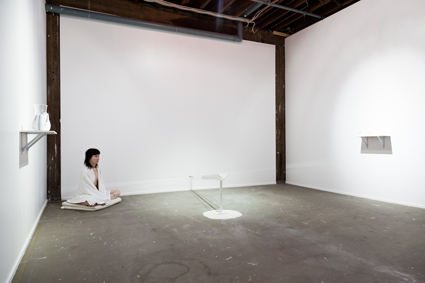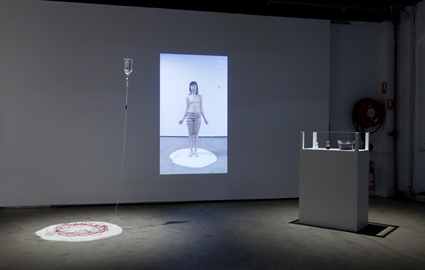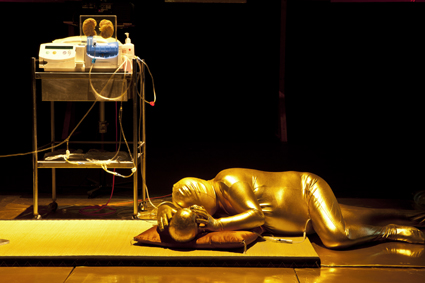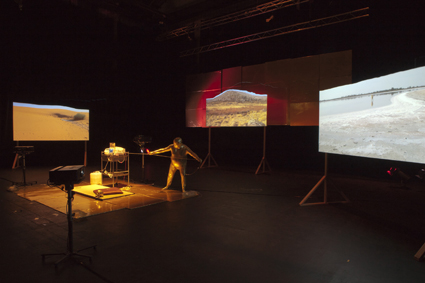performance art: going beyond
ella mudie: fiona mcgregor and john a douglas durational performances

Fiona McGregor, Water #3: Expulsion
photo silversalt photography
Fiona McGregor, Water #3: Expulsion
AT SURFACE LEVEL, THE WIDESPREAD PREVALENCE OF SLOW TIME IN VIDEO PRACTICES AND DURATION IN PERFORMANCE ART IS UNDERSTANDABLE AS A COUNTERPOINT TO THE AGE OF DISTRACTION IN WHICH WE LIVE. BUT THIS NATURAL FIT ALSO POSES A CHALLENGE FOR ARTISTS WORKING IN THIS VEIN, WHO MUST SEEK WAYS TO GO BEYOND WHAT HAS BECOME A MUCH USED ARTISTIC STRATEGY.
Two compelling durational performance installations presented in Sydney this November—Fiona McGregor’s Water Series and John A Douglas’s Body Fluid II— suggest durational work still has the capacity to challenge and engage audiences, although somewhat paradoxically it now appears most effective when approached in a multi-faceted way.
water series
Stillness, risk and endurance were the common threads running through McGregor’s Water Series, where for three weeks Artspace became home to her accumulative and visceral project comprising video and photographic artifacts of two earlier endurance works as well as three durational performances undertaken live in the gallery. Filling one room was Vertigo (2009), a four-hour and 50-minute film capturing one of McGregor’s initial engagements with water as she spent several agonising hours lying flat on a cliff at North Bondi facing directly out to sea to confront head-on her fear of heights (see RT Studio). Presented at MOP in February as a single linear projection, at Artspace McGregor adopted for Vertigo a multi-screen approach with six projections looping various vantage points including two cast directly onto the ground, recreating her both terrifying and awe inspiring view from the precipice. The effect of this panoramic seascape was to bring the viewer closer to the artist’s experience. Initially affecting as a subtle and slowly unfolding meditation upon the sea as psychic terrain, in this instance the experience of ocean as limit was compressed and forceful, the mental transition of moving beyond fear more immediately palpable.
Where the early works involved a bodily and psychological encounter with landscape (Tidal Walk [2009] saw McGregor walk laps of Bondi Beach for the 11.5 hour duration of a tide cycle) the newest installments were energised by the immediacy and vitality of an audience presence. The motivation was also less internal as McGregor’s more political concern for water scarcity was played out in the live endurance actions of having rainwater dripped continuously onto her salt covered body, the introduction of a saline drip into the body while having blood extracted, tattooing with water and the drinking of large quantities of water to produce urine to activate a small garden fountain. Traces were left in the gallery marking the sites of the actions, creating a ritualistic atmosphere that intensified the resonance of McGregor’s undertaking as the exhibition period progressed.

Fiona McGregor, Water series, installation
photo silversalt photography
Fiona McGregor, Water series, installation
These were challenging gestures that converged time, body and nature as a medium, transcending their literal messages to provoke more personal and subjective responses. For Descent #1, McGregor had envisaged enduring 24 hours under dripping water although as I arrived the performance had just concluded after five and a half hours as her body succumbed to the first symptoms of hypothermia. Watching the remaining water drip eerily from the latex bulb suspended from the ceiling and onto the hard plywood table where the artist had lain, a ghostly outline of her body imprinted in salt was a stark reminder of human frailty and the enduring power of performance art to jolt us from everyday complacency.
body fluid ii

John A Douglas, Body Fluid II
photo Alex Kershaw
John A Douglas, Body Fluid II
A few days later at Performance Space’s Clubhouse, John A Douglas’ 10-hour durational performance Body Fluid II took a very personal concern—the artist’s own reliance on life supporting medical treatments—and imaginatively stretched it to epic proportions, netting a broad variety of themes along the way. In a surreal setting melding the chintzy glamour of a lo-fi science fiction film set with the sparse interior of a hospital room, the artist began by lying prostrate on the floor while hooked up to a peritoneal dialysis machine, plastic tube protruding from his rotund Buddha belly. Dressed in a tight, shiny, gold bodysuit that covered eyes, nostrils and mouth, there was a wry humour in its resemblance to both submissive bondage attire and a Hollywood superhero costume gone awry, while an atmospheric soundtrack echoing the pulsing rhythm of a heartbeat with a primal, earthly rumbling completed the transition into this strange mythic-medical space.

John A Douglas, Body Fluid II
photo Alex Kershaw
John A Douglas, Body Fluid II
Against a backdrop of parched Australian bush, desert and salt lake landscapes projected across three screens, a mat of gold tiles formed the parameters of the performance space within which Douglas languidly unfolded choreographed movements spanning gentle grasps, reaches and mime-like hand actions to laboured walking and full body seizures and collapses. At the corner of the artist’s ‘hospital bed’ stood a gold skull, facing toward the audience as a memento mori. It was a fitting piece of symbolism for this unnerving yet humane meditation upon not only the physical and mental challenges of an ongoing illness but also, more broadly, how the fact of our mortality plays out in the psyche. Employing his body as a vessel to communicate diverse states, from burden, exhaustion, depletion and apathy to wonder, curiosity and renewal, Douglas effectively distilled in memorable images the see-sawing feelings that underwrite our ambivalent attitudes toward life and death.
Douglas’ work often subjectively reinterprets film and in Body Fluid II there was an open-ended dialogue with Nicolas Roeg’s 1976 cult classic The Man Who Fell to Earth. An identification with the quest of the ageless humanoid Newton (Bowie) to save his drought stricken planet worked to deepen the associations and, as the artist’s gold alien alter ego chimerically appeared then disappeared from the ancient landscapes on screen, I was reminded that we’re just visitors to this land in both the colonial context and when measured against the immense scale of deep-time. This close attunement to temporality linked both Douglas’ and McGregor’s performance installations but this was neither artist’s true subject. Rather, in these works time, water, energy and endurance must all eventually run out, which provokes an awareness of the finite nature of human existence. At times confronting, these were life affirming actions that resonate in an age of environmental crisis where the ability to care for a fragile world demands a recognition of our interdependent place in natural systems that we can impact on but not control.
Fiona McGregor, Water Series, Artspace, Nov 1-20; John A Douglas, Body Fluid II, Performance Space Clubhouse with Chalk Horse, CarriageWorks, Sydney, Nov 4
RealTime issue #106 Dec-Jan 2011 pg. 44






